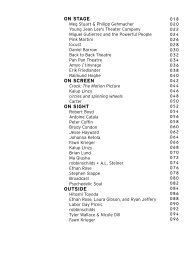BOMB Magazine: Shirin Neshat by Arthur C. Danto
BOMB Magazine: Shirin Neshat by Arthur C. Danto
BOMB Magazine: Shirin Neshat by Arthur C. Danto
Create successful ePaper yourself
Turn your PDF publications into a flip-book with our unique Google optimized e-Paper software.
you’ve done four films. What were you doing before the films?<br />
<strong>BOMB</strong> <strong>Magazine</strong>: <strong>Shirin</strong> <strong>Neshat</strong> <strong>by</strong> <strong>Arthur</strong> C. <strong>Danto</strong> 5/17/10 1:58 PM<br />
SHIRIN NESHAT I graduated from UC-Berkeley in 1983 and moved soon after to<br />
New York City where I quickly came to the conclusion that art making wasn’t going<br />
to be my profession. I felt what I was making was not substantial enough—and I<br />
was intimidated <strong>by</strong> the New York art scene. So I worked to earn money and took<br />
courses in various subjects. Soon after I met my future husband, who ran the<br />
Storefront for Art and Architecture, an alternative space in Manhattan. I dedicated<br />
the next ten years intensely to working with him at the Storefront, and that became<br />
my true education. Storefront functioned like a cultural laboratory, the program was<br />
quite cross-disciplinary; I was constantly working with artists, architects, cultural<br />
critics, writers and philosophers. This exposure eventually led me to think about<br />
myself as an artist and I wanted to make artwork again. During those ten years I<br />
made practically no art and what I did make I was quite dissatisfied with and<br />
eventually destroyed. So it was only in 1993 that I began to seriously make artwork<br />
again.<br />
AD And those were photographs?<br />
SN Yes, I thought photography was the most appropriate medium for my subject as<br />
it had the realism that I needed. In the 1990s I finally began going back to Iran. I<br />
had been away for over ten years—since the Islamic Revolution. As I traveled back<br />
and forth a lot of things started to go through my mind, which eventually led me to<br />
develop the work that I have. My focus from the beginning was the subject of<br />
women in relation to the Iranian society and the revolution, so I produced a series<br />
of photographic images that explored that topic.<br />
AD I was talking just last week with Susan Sontag, who said that, in her view, the<br />
Iranian film movement is the most remarkable in contemporary cinema. That’s quite<br />
an extraordinary claim. How do you account for that?<br />
SN I agree with her. I am very inspired <strong>by</strong> the new trend in Iranian cinema. In my<br />
opinion, it has been one positive aspect of the revolution, as it has in a way purified<br />
Iranian culture artistically <strong>by</strong> eliminating Western influences that had deeply<br />
infiltrated our culture. Before the revolution, Iranian film followed similar standards<br />
as in any commercial Western film, much of it was filled with superficiality, violence<br />
and sex. After the revolution, the government imposed severe codes; filmmakers<br />
had to reformulate their ideas, and as a result a new form of cinema was born that<br />
thrived in the midst of all the governmental censorship. These films have been<br />
successful for their humanistic, simple and universal approach. They reveal so much<br />
about Iranian culture without being overly critical. The pioneer of this generation of<br />
filmmaking, Abbas Kiarostami, is showing his most recent film, The Wind Will Carry<br />
Us, in New York starting in July.<br />
AD Let me ask about your first films. When you began to show them here were<br />
they more or less conventional, linear films with a single screen . . . or did you<br />
begin with the double-screen format right away?<br />
SN Turbulent was my first cinematic film. Prior to that, I had made a few videos<br />
which I consider very different; they were video installations, very sculptural, with<br />
no specific narrative, beginning or end.<br />
AD That was video as it was understood at that time: something projected on a<br />
wall, a nonnarrative, free play of images. Did you have sound?<br />
SN Yes, sound was always an important part of my work.<br />
AD And was it always music?<br />
SN Well, I had made some very simple rhythmic sounds with my own voice. For<br />
example, one of the pieces I made in Istanbul was of a woman—me, actually<br />
—running in four distinct types of spaces and projected on four screens,<br />
simultaneously. And in a piece called The Shadow Under the Web, I made a sound<br />
with my own voice, something between breathing and singing, repeated in different<br />
time signatures. I improvised it as we were recording. In Anchorage, which was a<br />
single projection, there was a combination of chanting and a very simple song, and<br />
again, I improvised.<br />
AD You composed those songs spontaneously?<br />
http://bombsite.com/issues/73/articles/2332 SN Yes, on the spot at the recording studio.<br />
2 of 10<br />
AD There must have been a moment when the ideas that began to be expressed in<br />
Turbulent came to consciousness. You took a shift, a change in direction; did you<br />
feel yourself on the threshold of something quite different? I remember seeing some






